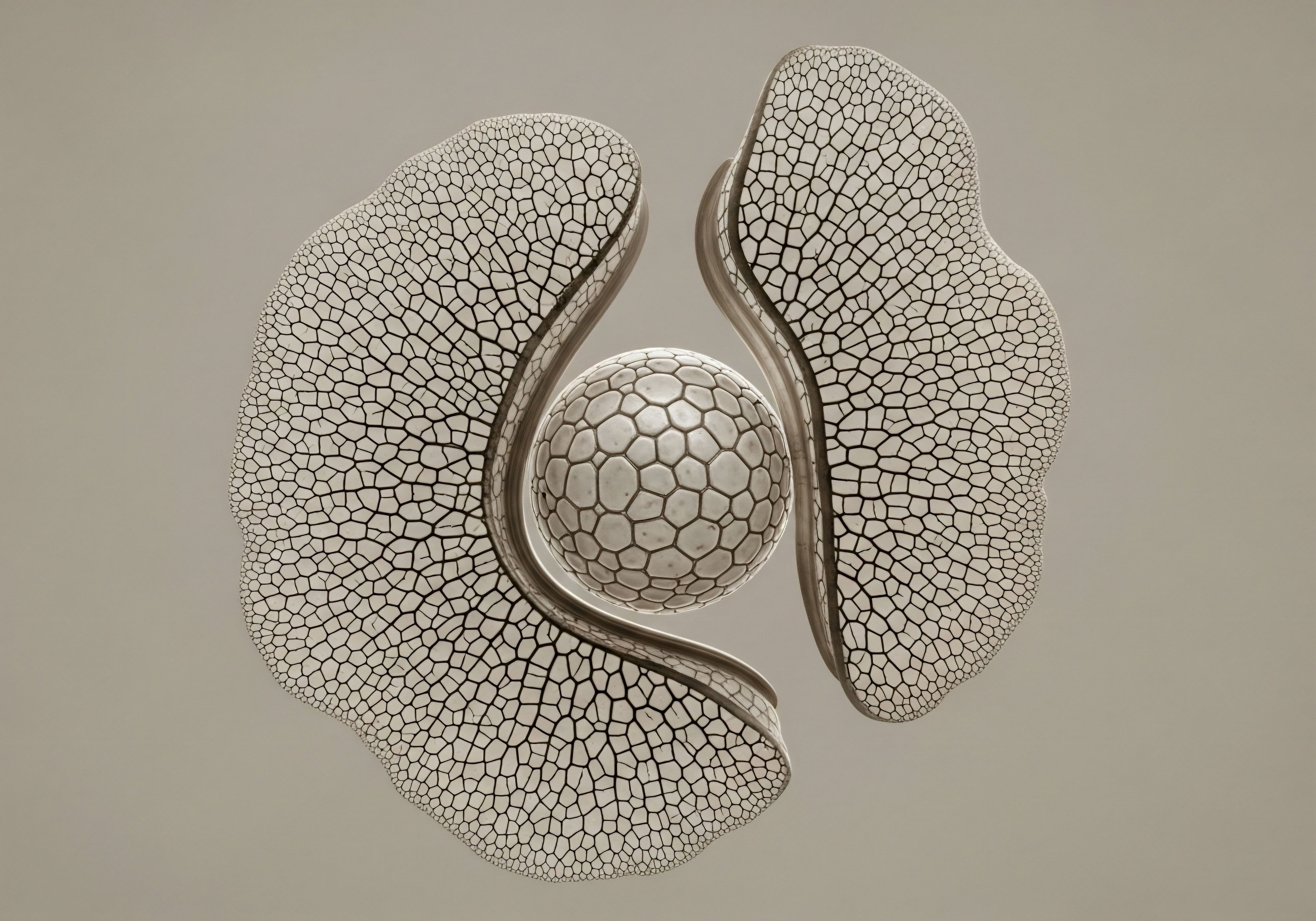

The Biological Imperative of Motion
The pursuit of an extended prime years challenges conventional wisdom. We acknowledge a biological reality ∞ the human organism thrives on movement. It is a fundamental command etched into our genetic code, a non-negotiable input for sustained vitality. The body, a complex network of finely tuned systems, requires specific kinetic stimuli to maintain optimal function. This understanding transcends mere exercise; it represents a profound engagement with our intrinsic biological design.
Age-related decline often presents as a series of cascading systemic failures. Hormonal production wanes, metabolic efficiency falters, and cellular repair mechanisms lose their edge. This decline manifests in tangible ways ∞ diminished cognitive sharpness, recalcitrant body composition shifts, and a noticeable reduction in physical and mental drive. Movement intervenes directly in these processes, acting as a potent signaling agent to restore and maintain equilibrium across the endocrine, metabolic, and neurological landscapes.
Consider the intricate dance of endocrinology. Testosterone, growth hormone, and insulin sensitivity are not static markers; they are dynamic participants in the symphony of performance. Sedentary patterns silence these crucial players. Intentional, strategic movement, conversely, amplifies their signaling, instructing the body to preserve muscle mass, mobilize fat stores, and enhance neuronal plasticity. The objective extends beyond physical appearance; it targets the very operating system of human performance.
Studies indicate that regular resistance training can increase natural testosterone production by up to 15% in men over 40, directly impacting lean muscle mass and cognitive function.
Mitochondrial health represents another critical frontier. These cellular powerhouses dictate our energy output and resilience. Their degradation accelerates aging. Movement, particularly high-intensity interval training (HIIT) and resistance work, acts as a powerful biogenic stimulus. It compels mitochondria to replicate, to function with greater efficiency, and to clear damaged components.
This cellular recalibration underpins sustained energy, sharper mental focus, and a more robust physiological reserve. Our cells respond to the demands we place upon them, forging a more resilient internal environment.
The neurochemical benefits of consistent physical activity are equally compelling. Dopamine, serotonin, and brain-derived neurotrophic factor (BDNF) are directly modulated by movement. These compounds are architects of mood, motivation, and learning. Engaging in purposeful physical challenges creates an internal chemistry that supports sustained cognitive performance and emotional resilience. We are, at our core, organisms designed for dynamic interaction with our environment. To deny this inherent need is to accept a diminished state.


Kinetic Alchemy for Vitality
Transforming the body’s chemistry through movement requires a precise, multi-modal approach. It involves a strategic blend of various physical disciplines, each designed to elicit specific physiological adaptations. This is not about generic workouts; it demands a nuanced understanding of how different forms of kinetic input translate into cellular and systemic upgrades. We architect a movement strategy that speaks directly to the body’s innate capacity for self-optimization.

Resistance Training ∞ The Anabolic Signal
Resistance training stands as a foundational pillar. It provides the most potent anabolic signal, directly influencing muscle protein synthesis and bone mineral density. Lifting heavy weights, employing progressive overload, triggers a cascade of hormonal responses. It stimulates growth hormone release and improves insulin sensitivity, making the body more efficient at utilizing nutrients for repair and growth. This type of movement directly combats sarcopenia, the age-related loss of muscle mass, preserving strength and metabolic rate.
Consider the cellular impact. Mechanical tension on muscle fibers initiates signaling pathways that drive cellular repair and adaptation. This is a direct command to the body to rebuild stronger, more resilient tissue. Incorporate compound movements like squats, deadlifts, presses, and rows. These engage multiple muscle groups simultaneously, maximizing hormonal and metabolic responses.
- Prioritize compound lifts with progressive overload.
- Implement 3-4 sessions per week, focusing on major muscle groups.
- Vary rep ranges to stimulate different muscle fiber types and adaptation pathways.

Cardiovascular Conditioning ∞ Metabolic Efficiency
Cardiovascular work refines the body’s metabolic engine. High-intensity interval training (HIIT) and Zone 2 steady-state cardio each offer distinct advantages. HIIT enhances mitochondrial biogenesis and improves cardiorespiratory fitness, directly impacting endurance and the body’s ability to clear metabolic waste. Zone 2 training, performed at a moderate intensity, builds aerobic capacity and improves fat oxidation, teaching the body to burn fat efficiently for fuel.
The interplay between these two modalities is synergistic. HIIT delivers powerful acute stimuli for adaptation, while Zone 2 provides the endurance base for sustained performance and recovery. A well-conditioned cardiovascular system underpins every other physiological process, ensuring efficient nutrient delivery and waste removal. This is a vital component for overall systemic health.

Mobility and Stability ∞ The Structural Integrity
Movement quality matters as much as quantity. Mobility and stability work ensure the body moves with grace, efficiency, and resilience. This includes practices like dynamic stretching, yoga, Pilates, or specific functional range conditioning. These modalities enhance joint health, improve proprioception, and reduce the risk of injury. A body that moves well performs better and maintains its structural integrity across decades.
Neglecting movement quality compromises overall performance and increases vulnerability. Think of it as maintaining the suspension system of a high-performance vehicle. A well-oiled, flexible system translates power more effectively and endures stress with greater resilience. This is a proactive investment in the longevity of your physical capabilities.
Engaging in regular Zone 2 cardiovascular training has been shown to improve endothelial function by over 20%, a key marker for cardiovascular health and longevity.


Strategic Adaptation for Enduring Prime
The timing and progression of movement protocols are paramount for sustained results. A static approach yields static outcomes. We engage in a dynamic process of adaptation, adjusting our kinetic inputs based on biological feedback and evolving goals. This demands an intelligent, iterative strategy, mirroring the body’s own adaptive capabilities.

Phased Integration of Modalities
Initiate with a foundational phase, emphasizing movement competency and building a robust aerobic base. This establishes the structural and metabolic readiness for more intense work. Gradually introduce resistance training, focusing on form and progressive overload. Once a solid base is established, integrate targeted HIIT sessions and specialized mobility work. The body responds best to a systematic increase in demand, allowing for optimal adaptation without excessive stress.
Consider individual response metrics. Recovery, sleep quality, and subjective energy levels offer invaluable feedback. Biomarkers, such as hormone panels and inflammatory markers, provide objective data points. These insights guide adjustments to training volume, intensity, and modality. This is a personalized optimization loop, ensuring that the kinetic inputs consistently drive progress.

Optimizing Recovery and Regeneration
Movement represents a powerful stimulus; recovery represents the period of adaptation. Prioritize sleep hygiene, nutrient timing, and stress management. Active recovery, such as light walks or gentle stretching, can enhance blood flow and aid in waste removal. Cold exposure and sauna use are additional tools that can accelerate recovery and promote cellular resilience. These are not passive acts; they are active components of the movement strategy, allowing the body to fully capitalize on the training stimulus.
The goal extends beyond mere physical output. It involves cultivating a lifestyle that supports peak performance across all domains. This integrated approach acknowledges the interconnectedness of movement, nutrition, sleep, and mental well-being. Each component amplifies the efficacy of the others, creating a powerful synergy for sustained vitality.
Longitudinal studies reveal that individuals consistently engaging in varied physical activity patterns exhibit biological aging rates up to 5-10 years slower than sedentary counterparts.
Anticipate plateaus and periods of reduced performance. These are signals for strategic deloads or modifications. The body requires variation to continue adapting. Introducing new stimuli, altering exercise selection, or periodizing intensity prevents stagnation and fosters continued progress. This intelligent manipulation of training variables maintains the upward trajectory of performance and resilience.

Sustaining the Unrivaled Self
The commitment to movement represents more than a health regimen; it embodies a declaration of intent. It signifies a refusal to passively accept the default settings of aging, choosing instead to actively engineer a future defined by vitality and peak performance. The kinetic alchemy we pursue transforms the biological landscape, allowing us to not just exist, but to thrive with an enduring edge.
This path requires unwavering dedication, a deep understanding of the body’s intricate systems, and a willingness to continually adapt. It is a journey of constant refinement, where every intentional movement contributes to the masterpiece of an optimized self. The reward extends beyond physical prowess; it encompasses a heightened state of cognitive function, emotional resilience, and an unwavering capacity to engage fully with life. We forge our prime years, one purposeful movement at a time.



